21 June
lecture series
ON CULTURAL HERITAGE IN THE BAZTAN VALLEY
"Of oaks and races". Baztaneses in Mexico: in their footsteps here and there
José Javier Azanza López
Chair de Patrimonio y Arte Navarro
In this new approach to topic of the emigration of the people of Baztan to America in the 19th and 20th centuries, we use as a guiding thread the extraordinary issue published by the graphic magazine La Esfera in 1929.
Founded in Madrid in 1914, La Esfera marked an era and was the best magazine of its time, devoting its pages to the publication of lavishly edited articles and chronicles of general current affairs, both from Spain and other countries. In June 1929, on the occasion of the Ibero-American exhibition inaugurated in Seville on 9 May of that year and closed on 21 June 1930, it devoted an extraordinary issue of almost 250 pages to Mexico (Fig. 1), one of the countries participating in the sample with its pavilion erected on the Paseo de las Delicias in accordance with project by the architect Manuel María Amábilis Domínguez of Mérida (Yucatán).

La Esfera. issue extraordinary dedicated to Mexico. June 1929. Cover.
After the formal greeting by the President of the Mexican Republic, Emilio Portes Gil, provisional , the magazine included articles of a very varied nature that brought the reader closer to the historical, social, urban, artistic and cultural reality of the country. In addition to all this, there was a series of reviews that dealt with the economic, commercial and financial panorama of the country at a time of industrialisation brought about to a large extent by immigrants from the different regions of Spain. And among these there was no shortage of people from Navarre and, more specifically, those from Baztan.
The most prominent was Braulio Iriarte, a native of Elizondo, whom the magazine presented under the significant degree scroll "Los robles de la raza" (Fig. 2). The "captain general of the Basques in Mexico", as he was called on this occasion, launched some of the most significant business projects of the time: the large flour mills, with special significance for the El Éuskaro mill (today Harinera Nacional) founded in 1906; the brewery model, which opened its doors in 1925 to manufacture the Corona and model brands; and Leviatán y Flor, the first yeast factory in Mexico; without forgetting his role in the world of finance through credit Español de México, a banking institution founded in 1920, of which he was the first president. The magazine was explicit in its conclusion: "No one in the country has better eyesight, development of economic intelligence and high regard in finance and industry... There is no strong negotiation in the national territory that has not received the first breath, the first money and the first committee from Mr. Braulio Iriarte, the cornerstone of big business".
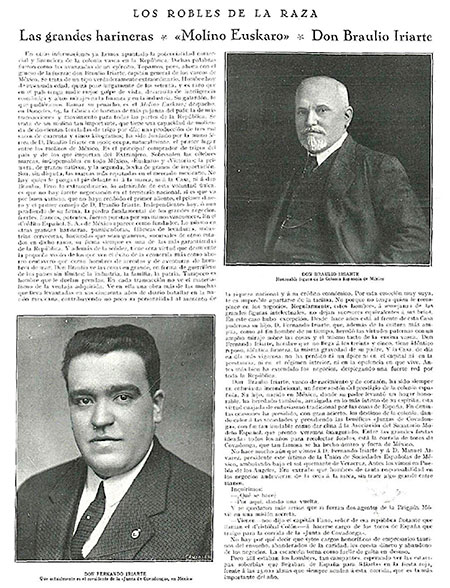
"Los robles de la raza", La Esfera. issue extraordinary dedicated to Mexico. June 1929, n.p.
The second man from Baztan recognised in the magazine was Juan Irigoyen, "that young lad whose roads of Errazu nostalgically recall his wanderings and still await him like open arms in the land", who in Mexican territory had become "one of the strongest columns of the Basque Centre, contributing to its growth and splendour", according to the magazine (Fig. 3). In this case, his figure is associated with the El Carmen mill in Celaya, one of the oldest in the country as a large-scale flour mill, without forgetting his support for other initiatives such as the reform of the high school de las Vizcaínas in 1907-1910.
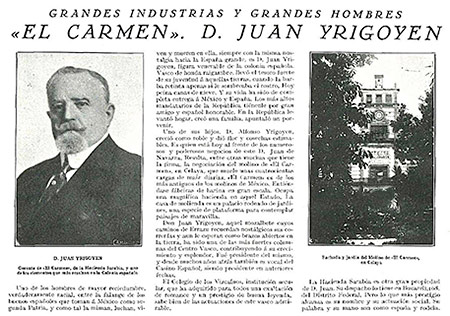
"Great industries and great men", La Esfera. issue extraordinary dedicated to Mexico. June 1929, n.p.
The third significant name of the people from Baztan in Mexico is that of Juan Urrutia Ezcurra, a native of Oronoz. In this case, he is linked to the textile industry through the cloth factory that bears his name, with the reputation of being the best national cloth manufacturer and which gives rise to the following comment: "A cloth from the House of Ezcurra is a guaranteed cloth. Is it English cloth? No. It is Urrutia and Ezcurra. And that's enough. No factory achieves the quality that this one does" (Fig. 4).
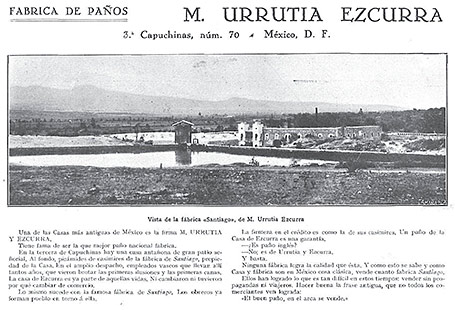
"Fábrica de paños M. Urrutia Ezcurra", La Esfera. issue extraordinary dedicated to Mexico. June 1929, n.p.
Marcelino Zugarramurdi, from Arizkun, "a strong Navarrese lion with regional lawin his paw", owner of the La Vasconia biscuit factory, is added to the above. And although they do not come from Baztan, the magazine also includes references to other Navarrese, such as Fermín Echandi, from Beintza-Labayen, co-founder with Braulio Iriarte of the mill El Éuskaro; Martín Oyamburu, originally from Lizaso, linked to the dairy industry from his stable Los Pirineos; and Ambrosio Izu, from Biurrun and General Manager of the fabric factory La Carolina.
Now that the trajectory of the Baztaneses there is known through the pages of La Esfera, we remember what their mark was here. We start with the eloquent fact that, in the subscription opened among the residents of Baztan in Mexico to help the victims of the 1913 floods, those who distinguished themselves most were Braulio Iriarte and Juan Irigoyen with donations of 1,840 pesetas, followed by Martín Urrutia with 1,000 pesetas.
In the case of Braulio Iriarte, the obituary published in the Diario de Navarra on 8 July 1932 on the occasion of his death recalled "the important works carried out in this town thanks to his boundless generosity and magnanimity of spirit. There are the towers of our magnificent parish church (Fig. 5); there is the beautiful pediment; there is the bridge over the river Baztan that gives access to the street that bears his name".
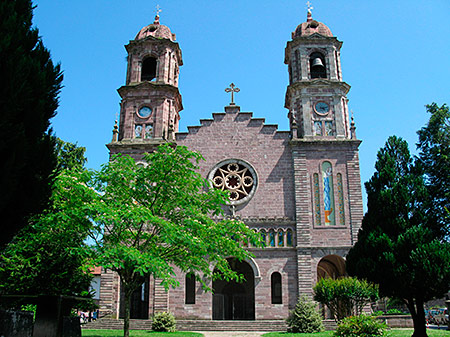
Elizondo. Parish Church of Santiago.
Juan Irigoyen was also a benefactor of his hometown, where he donated the fronton and helped rebuild the church after the flood of 1913; and in 1928 he gave the parish the belfry bell that was built by refurbishing the previous one. His brother José, who also worked at the El Carmen mill, paid for the town's monumental cemetery in 1912 (Fig. 6); both also rebuilt his birth house and in 1908 paid for a public washing place with source and a trough next to it.
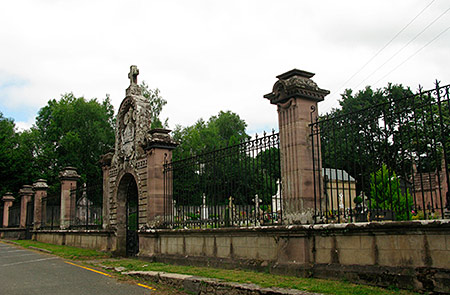
Erratzu. Cemetery.
Martin Urrutia was an enterprising man both in Mexico and in his hometown, showing a special concern for collaborating with school Education in order to lay the foundation for generations with better preparation. Thus, the schools of Tulancingo and Santiago Tulantepec, both in the State of Hidalgo, received his financial support and today bear his name. In Oronoz, Martín Urrutia and his wife Carmen Lanzagorta allocated one million pesetas in 1927 for the foundation of two teaching centers: the San Martín (Fig. 7) and Nuestra Señora del Carmen schools, under the tutelage of the Marist Brothers and the Daughters of Charity respectively, destined to "provide the boys and girls of Oronoz-Mugaire and the nearby towns with solid instruction and Christian Education ", in Urrutia's own words. He was also position for the enlargement and embellishment of the parish church, as well as the construction of the new cemetery where the family pantheon was installed and the municipal fronton built at the expense of Carmen Lanzagorta in report her son Juan, in addition to the generous donations to the Casa de Misericordia del Valle (House of Mercy of the Valley).
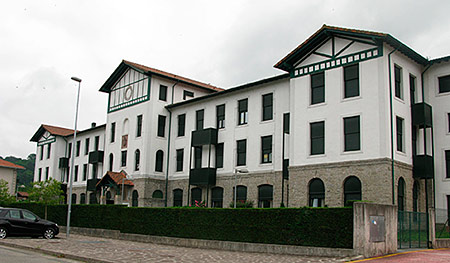
Oronoz. Former high school of San Martín.
